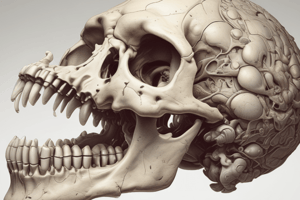Podcast
Questions and Answers
What are the three different types of lamellae found in bone?
What are the three different types of lamellae found in bone?
- Circumferential lamellae
- Concentric lamellae
- Interstitial lamellae
- All of the above (correct)
Describe endochondral bone formation.
Describe endochondral bone formation.
Endochondral ossification forms most bones in the body, replaces cartilage with bone.
What are the different types of bone cells?
What are the different types of bone cells?
Osteogenic, osteoblasts, osteocytes, osteoclasts.
The organic component of bone is primarily made up of ______.
The organic component of bone is primarily made up of ______.
How does bone grow in diameter?
How does bone grow in diameter?
Where is red bone marrow found in an adult human?
Where is red bone marrow found in an adult human?
What is the periosteum?
What is the periosteum?
Define a threshold stimulus.
Define a threshold stimulus.
What happens during the depolarization phase of an action potential?
What happens during the depolarization phase of an action potential?
Skeletal muscle fibers are under involuntary control.
Skeletal muscle fibers are under involuntary control.
Match the following functions of the skeletal system:
Match the following functions of the skeletal system:
Flashcards are hidden until you start studying
Study Notes
Types of Lamellae in Bone
- Circumferential Lamellae: Forms the outer surface of compact bone; consists of thin plates extending around the bone.
- Concentric Lamellae: Circular layers of bone matrix surrounding the central canal.
- Interstitial Lamellae: Located between osteons; remnants of osteons partially removed during bone remodeling.
Bone Formation Processes
- Intramembranous Ossification: Forms flat bones of the skull, face, jaw, and central clavicle; bone develops from sheets of mesenchymal connective tissue.
- Endochondral Ossification: Forms most bones in the body, especially long bones; replaces cartilage with bone.
- Cranial Sutures: Connect the bones of the skull in infants; allow flexibility until fused around age 2.
- Fontanels: Soft spots on an infant's skull where sutures intersect.
Types of Bone Cells
- Osteogenic Cells: Line the inner periosteum and produce new bone cells through mitosis.
- Osteoblasts: Secrete bone matrix and have a high metabolic rate; become trapped in lacunae.
- Osteocytes: Mature bone cells surrounded by matrix, exhibiting a low metabolic rate.
- Osteoclasts: Macrophages that break down old bone tissue.
Bone Composition
- Inorganic Component: Mostly calcium and phosphorus in the form of hydroxyapatite crystals.
- Organic Component: Primarily Type I collagen, constituting 35% of bone's dry weight.
Bone Growth
- Length Growth: Occurs at the epiphyseal plate.
- Diameter Growth: Achieved through modeling and remodeling processes.
Blood Supply to Osteocytes
- Blood flows through periosteal arteries into perforating canals, supplying the periosteum and outer compact bone.
Healing of Fractures
- Involves several stages such as hematoma formation, callus formation, and eventual bone remodeling.
Functions of the Skeletal System
- Support: Provides structural support to the body.
- Protection: Shields soft tissues, e.g., rib cage protects heart/lungs; skull protects the brain.
- Movement: Bones facilitate voluntary movements through muscle attachment.
- Blood Cell Production: Bone marrow produces blood cells.
- Mineral Homeostasis: Stores calcium and phosphorus, releasing them when needed.
Categories of Bones
- Long Bones: E.g., femur, humerus.
- Short Bones: E.g., carpals, tarsals.
- Flat Bones: E.g., skull, sternum.
- Irregular Bones: E.g., vertebrae.
- Sutural Bones: Found in cranial sutures.
- Sesamoid Bones: E.g., patella.
Locations of Red and Yellow Bone Marrow
- Red Bone Marrow: Found in flat bones and proximal ends of long bones; site of blood cell production.
- Yellow Bone Marrow: Stores fat; located in the medullary cavity in adults.
Periosteum and Endosteum
- Periosteum: Connective tissue covering bones; consists of an outer fibrous layer and an inner osteogenic layer.
- Endosteum: Thin connective tissue lining internal bone surfaces and cavities.
Structure of an Osteon
- Composed of concentric circles of bone ECM; osteocytes are housed within lacunae.
Types of Muscle Tissue
- Cardiac Muscle: Striated, involuntary, found in heart walls.
- Smooth Muscle: Non-striated, involuntary, located in hollow visceral organs.
- Skeletal Muscle: Striated, voluntary, attached to the skeleton.
Muscle Structure Components
- Myofibril: Arranged in bundles within muscle fibers; primarily composed of actin (thin filaments) and myosin (thick filaments).
- Sarcomere: Fundamental contracting unit of muscle, defined from Z line to Z line.
Connective Tissue Wrappings in Muscles
- Epimysium: Surrounds entire muscle.
- Perimysium: Encases bundles of fibers (fasciculi).
- Endomysium: Surrounds individual muscle fibers.
Nervous System Overview
- Somatic Nervous System: Relates to body wall and framework; includes sensory and motor divisions.
- Visceral Nervous System: Relates to internal organs, includes autonomic divisions controlling involuntary actions.
Action Potential Generation
- Resting Potential: Established when the cell is inactive.
- Depolarization and Repolarization: Changes in membrane potential that enable impulse transmission.
Muscle Contraction Events
- Initiated by a nerve impulse leading to the release of acetylcholine; this triggers calcium ion release, leading to cross-bridge cycling and muscle fiber shortening.
Threshold Stimulus and All-or-Nothing Response
- Threshold Stimulus: Minimum energy required for muscle contraction; if met, the muscle fiber will contract with full force.
Synaptic Transmission
- Acetylcholine: Neurotransmitter released at synapses; binds to receptors to propagate signals.
- Cholinesterase: Enzyme that breaks down acetylcholine, stopping the signal.
Phases of a Simple Muscle Twitch
- Latent Period: Brief delay before contraction (2-3 msec).
- Contraction Phase: Actin and myosin interactions lead to muscle tension.
- Relaxation Phase: Myosin detaches, tension decreases.
Energy Supply for Muscle Contraction
- Energy derived from pathways such as glycolysis, Krebs cycle, electron transport, creatine phosphate, and anaerobic respiration. Understanding the shift in energy sources during strenuous activity is crucial.
Studying That Suits You
Use AI to generate personalized quizzes and flashcards to suit your learning preferences.




